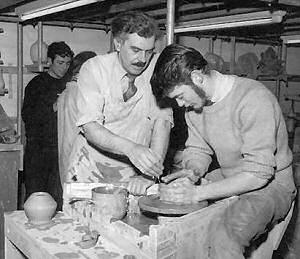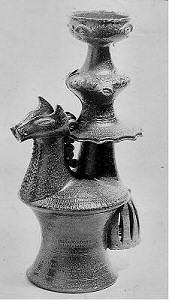
David Ballantyne teaching at Bournemouth College of Art

David Ballantyne - Circus horse, ca. 1970
Training and the War Years 1931 - 1946
In 1931 David became a full-time student at the Liverpool School of Art. In his final year at the school he won the annual travelling scholarship for figure composition. With his great friend, Ricardo Bitelli, he travelled for six weeks in France where he developed an abiding love of France and all things French.
The Ballantyne family moved to London in 1935, where David continued his art studies at the Central School of Art and Design, taking ceramics under the formative influence of Dora Billington, as well as textile design. He also took the art teacher’s diploma at the University of London Institute of Education.
David began his first job in 1937, as a teacher
of art at West Ham Grammar School. At the outbreak of war the
school was evacuated to Felixstowe and later shared premises with
Wellingborough Grammar School in Northamptonshire.
Bridgnorth 1946 – 1950
After the war David taught art at Bridgnorth Grammar School. In this environment his creative powers blossomed, and his inventive energy took him into new areas of kiln and kick-wheel design, fabric printing and furniture.
At this time he set up Saviac Workshops with George Trevelyan (later Sir George), the newly appointed director of Attingham Park, an adult education centre in Shropshire for which David had been commissioned to design and print all the furnishing fabrics. Saviac workshops (through which David carried out all his private work) aimed to offer design services of quality and integrity for any purpose, no matter how mundane or practical. The acronym, standing for Striving After Values In An Age Of Crisis, reflected a creative struggle which he never gave up.
Bournemouth College of Art 1950 – 1967
David’s task in Bournemouth was to expand the pottery department and set up a new department of fabric design. Around 1953 the fabric (and wallpaper) department was abandoned due to the work pressures generated by the pottery. The pottery course, which was highly regarded, flourished attracting eminent potters as visiting lecturers and assessors, including David Leach, Alan Caiger-Smith and Henry Hammond. The college was affected by the reorganisation of art education in the 60s, which led to pottery being included in a new department of Environmental Design, along with interior design, painting and sculpture.
David regarded his own pottery work as being closely linked to his teaching. Peter Stoodley recalled:
“Throughout the whole of his career
David kept an active workshop at home, making and selling pots.
His unity of mind saw no distinction between teaching and doing.
The doing led directly to the teaching and vice-versa.”
David was one of the first post-war potters to use salt-glaze,
firing in a unique drip-feed oil kiln built by himself at home.
He used a porcellaneous body and decorated the pots by impressing
and engraving through painted slips. He saw salt glaze as an unjustly
neglected English tradition whose renaissance he sought, in spite
of the technical problems it presented.
He later wrote:
“Despised and rejected of craft potters since Leach, 18th Century Staffordshire embodies all those qualities most unassimilable into the vernacular .... an ever-increasing compulsion to press on in homage to those who attained such subtlety, grace and power in what, after all, is a refined form of drain-pipe.”
Together he and Peter Stoodley designed and built moderately-priced items needed by the potter such as a geared kick-wheel, described as ‘the Rolls Royce of kick-wheels’ gas-fired kilns and the like. Their most successful product was the SK110 geared wooden-framed kick-wheel, its unique feature being the adjustable pedal unit which eliminated any pumping action and could be quickly adjusted to suit any stature. The design was later developed for mass production by Wengers of Stoke-on-Trent.
Bournemouth 1967 – 1978
In 1967 the family moved into their new contemporary styled house in Chewton Farm Road, Highcliffe. It was designed for David by his colleagues at the college Hitchcox and King around the piano and workshop. This move, to a purpose built environment of space and light, was a catalyst for the diversification of his work. In the spirit of the times he freed himself from the limitations and conventions of the traditional craft studio potter not only to explore unfamiliar materials, techniques and scale, but to exercise his creativity in broadening the craftsman’s remit.
Collaboration with architects, and notably with the Scottish concrete poet Ian Hamilton Finlay, were the most lasting and significant activities of his later working life. Three areas of specialisation developed from the collaborations and were to become his trademarks: ground-laid enamels, calligraphy and integrated building elements.
David had seen the technique of ground-laid enamels at Wedgwood and he revived this lost-art, first on small trinket pots then on much larger pieces. Both this technique and his growing mastery of calligraphy were encouraged by Finlay for his collaborative works but David used them together to best effect in his commemorative plaques and platters.
David’s first building element commission, in 1974, was for a tiled wall in the cafeteria at Oxford Railway Station (now demolished). It depicted the dreaming spires and industrial history of the town in abstract relief. The second consisted of modern terracotta roof finials for a new building for the Spastics Society.
Vincent Wood studied under David and Peter Stoodley in the mid-1970s and later worked for David in his home studio. Vincent remembers a poem that David gave him as a lesson in calligraphy which has stuck in his mind for over 40 years:
Scintillate scintillate globule vivific, |
Post Retirement 1978 – 1990
Though he was no longer formally teaching, he continued his interest in crafts education by examining and by becoming advisor to Falmouth College of Art. He also continued a long tradition of tutelage to younger craftsmen and women who worked under his direction in his workshop.
Retirement freed David to explore the most promising avenues of his previous work in more depth. Two areas in particular proved central – his revised interest in painting and also integrated decorative elements in buildings. Collaborations in the restoration of historic houses led to the manufacture of air bricks, ceramic tiles and terracotta roof-tiles. These items were mass-produced (often using moulds) but made and finished by hand in the workshop, thus imprinting on them the craftsman’s stamp. Work initiated by David for English Heritage, included manufacturing replacement airbricks for the refurbishment of 68 Napoleonic forts along the Channel coast.
David’s last 20 years were increasingly dominated by a compulsive search, both for the time and for the means to express to the world what he had to say, and to bring to fruition all the multitudinous projects his fertile mind conceived. At the time of his death he had just completed the tiles for the Poole Quay development and was working on a commemorative plaque for the Bournemouth Cricket Pavilion. He had taken on a full-time assistant in the workshop for the purpose of passing on all the knowledge and skills of his 76 years to a younger generation.
David Ballantyne died on July 11th 1990, unexpectedly, after a short illness. Over the next few months his wife Katharine, with the help of friends and family, completed some of David’s unfinished commissions. Katharine sadly died on January 30th 1994.
In talking to many people about David Ballantyne they have all recalled him fondly and often with glowing accounts of his enthusiasm, inspiration and kindness. Nobody has had a bad word to say. This is probably best summed up in David’s obituary which appeared in the Independent newspaper and was written by Emmanuel Cooper, the eminent potter and one time student of David Ballantyne. He wrote:
“Modest and unassuming as a teacher and an artist, his creative influence has benefited generations of students and craftspeople.”